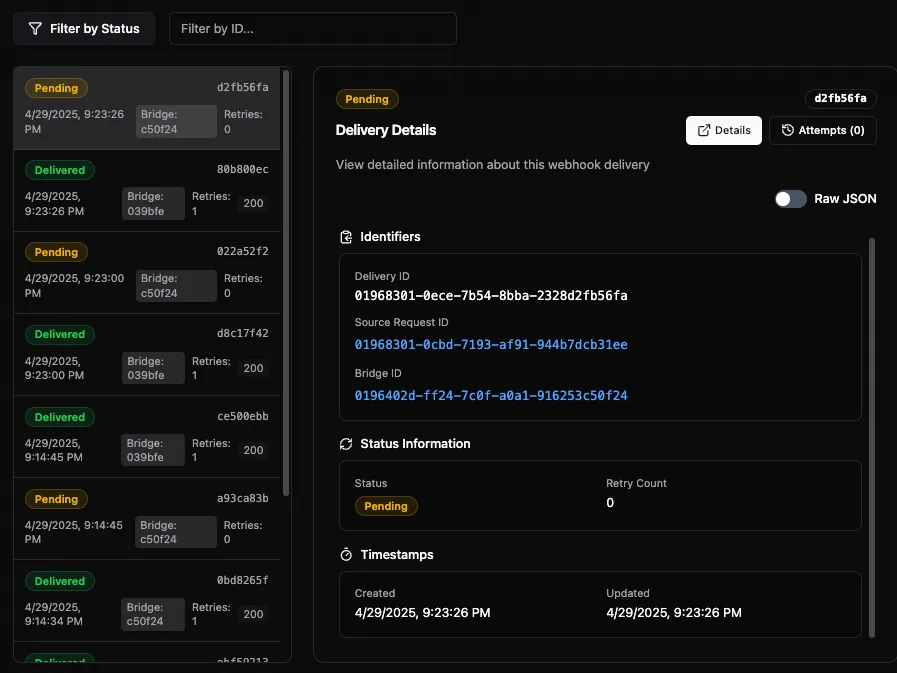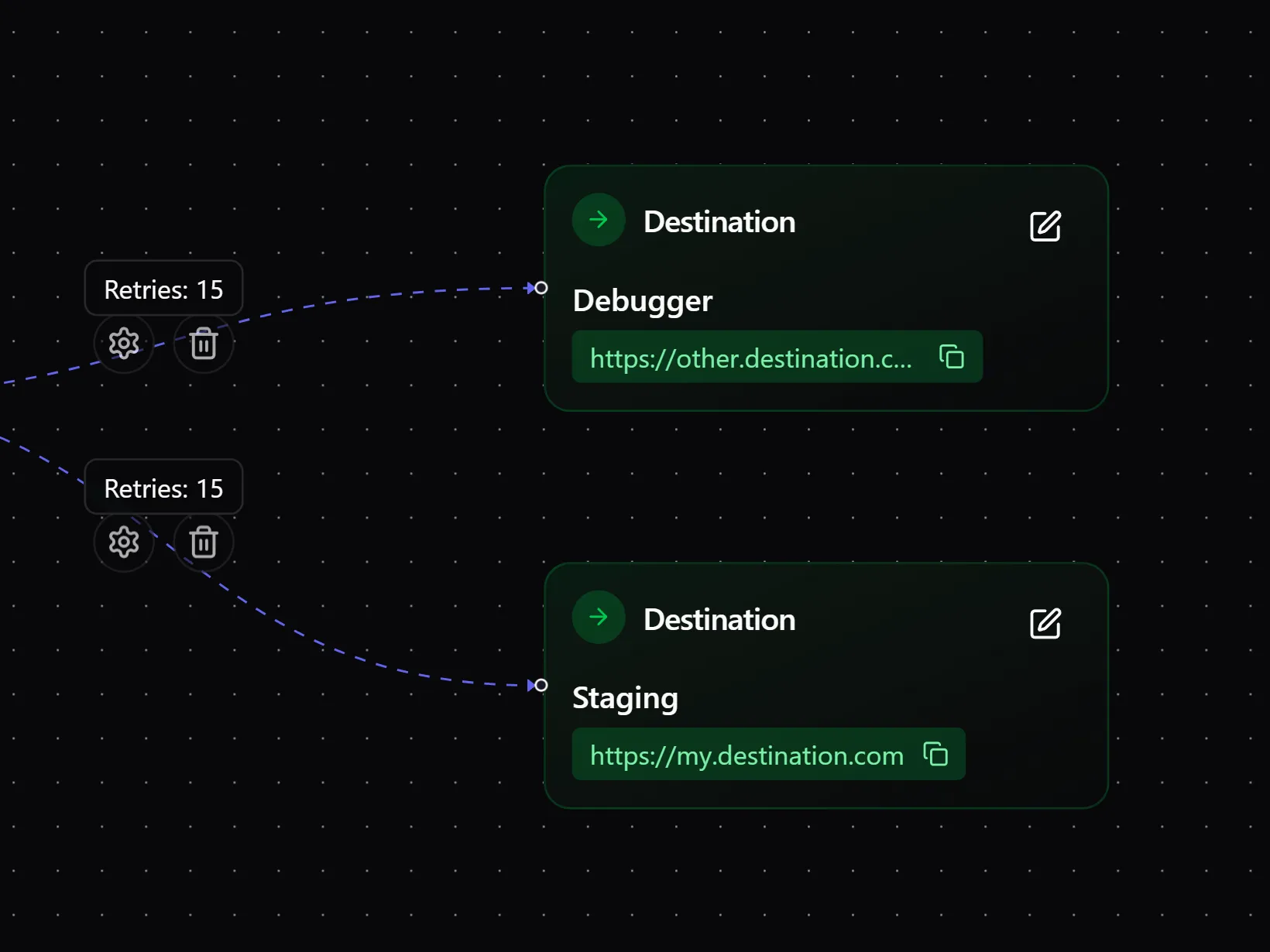Instant clarity for every webhook payload.
Capture, inspect, and replay requests in seconds with the Hooklistener debugger.
Hooklistener is now fully focused on the webhook debugger. Spin up a listener, watch payloads stream in live, replay to any environment, and annotate incidents without adding a single line of code.
History
14 days
Endpoints
Unlimited
Replay
Diff & notes
Step 1 • Incoming webhook
Step 2 • Stored & inspected
Hooklistener debugger
The payload is preserved for 14 days, signature-checked, and streamed into the live inspector so you can replay or diff it later.
{
"event": "payment_intent.succeeded",
"customer": "cus_9J4Z",
"amount": 2400
}
Step 3 • Replay anywhere
Send the same payload to any destination
Production API
200 OK
Response 127ms
Local tunnel
Replay queued
Awaiting ngrok
Trusted by engineers at
Built for the moments your debugger matters most
Every team follows the same flow—capture the webhook, inspect the payload, replay the request—whether they're shipping features or triaging outages.
Prefer a different workflow? Anything that sends HTTP can point at the debugger.
See how the debugger worksThe debugger replaces a week of log-diving
Capture, inspect, replay, and document every webhook in a single surface that everyone can open—no custom tooling or new SDKs required.
Capture every request
Inspect instantly
Replay with confidence
Collaborate in the same pane

Debugger workflow
Capture in seconds
Create a Hooklistener URL, point your vendor at it, and the debugger starts storing every request with headers, payload, and metadata.

Inspect with context
Search payloads, validate signatures, annotate failures, and share the live link so anyone on the team can see the same request.

Replay & automate
Send the payload to prod, staging, or localhost, diff responses, and convert fixes into reusable automations when you’re ready.

Captured in seconds, inspected forever
Before: direct webhooks, zero context when something failed. After: Hooklistener sits in front, the debugger keeps every payload, and replaying failures is a single click.
// My original webhook handler (circa March 2024)
app.post('/stripe-webhook', async (req, res) => {
try {
const event = stripe.webhooks.constructEvent(
req.body, sig, process.env.STRIPE_WEBHOOK_SECRET
);
if (event.type === 'payment_intent.succeeded') {
await updateUserSubscription(event.data.object.customer);
}
res.status(200).send('ok');
} catch (err) {
console.log('Webhook signature verification failed:', err.message);
res.status(400).send('Webhook Error');
// Stripe won't retry this 😬
}
});
// What I'd see in logs during a bad deploy:
[Mar 15 14:23:45] Error: Cannot read property 'customer' of undefined
[Mar 15 14:23:45] Error: Cannot read property 'customer' of undefined
[Mar 15 14:23:45] Error: Cannot read property 'customer' of undefined
// 73 failed payment webhooks while I was at lunch200 OK • 127ms
Retrying... • Attempt 2/5
200 OK • 89ms
Faster incident response
Document while you debug
Safe to share
Frequently asked questions.
What is a webhook?
What is Hooklistener?
Why do teams choose Hooklistener over webhook.site or Hookdeck?
- Visual Bridges orchestrate Sources, Destinations, filters, and transformations with one interface, including multi-destination fan-out and per-destination logic.
- Reliability guardrails such as exponential retries, circuit breakers, deduplication, and replay protection keep deliveries flowing even during downstream incidents.
- Deep observability with searchable event history (up to 90+ days), Issues, and analytics expose every step from incoming request to delivery attempts.
- Team and compliance features — shared organizations, role-based access, secret management, and enterprise audit logs — make Hooklistener fit for regulated teams.
Can I use Hooklistener for free?
How do I set up an endpoint to debug webhooks?
- Log in and open the Debug Endpoints section inside your organization.
- Click New Endpoint, optionally choose a forwarding URL, and enable signature checks if needed.
- Send a test webhook — you'll see headers, payloads, replays, and delivery attempts in real time.
- Share the inspection URL with teammates or clients to collaborate on troubleshooting safely.
Can Hooklistener replace request bins for production webhooks?
How does Hooklistener guarantee webhook delivery reliability?
What routing and payload transformations are available?
How does Hooklistener handle security, compliance, and audit trails?
How long are webhook payloads retained and can I export them?
/requests and /webhook-deliveries — to export events to your data warehouse before the retention window closes.How does Hooklistener support teams and collaboration?
Can I test webhooks locally and share inspections with clients?
Which integrations and destinations does Hooklistener support?
How do I migrate from webhook.site or Hookdeck to Hooklistener?
- Create a Source or Debug Endpoint that mirrors the URL you expose to partners.
- Use the Bridge builder to recreate your forwarding rules, filters, and transformations.
- Forward traffic through Hooklistener while keeping your legacy endpoint as a destination to verify parity.
- Review the Issues dashboard for discrepancies, then update your providers to the new Hooklistener URL.
What subscription is best for me?
Choose a plan that matches your webhook volume and team structure:
- Free: 1,000 events/month, three Bridges, essentials for solo developers validating integrations.
- Team: 100,000 events/month, 30-day retention, API keys, role-based access, and usage dashboards for growing companies.
- Enterprise: Custom quotas in the millions, 90+ day retention, audit logs, SLA, and dedicated support for mission-critical workloads.
Start debugging webhooks in under a minute
Hooklistener is now laser-focused on the webhook debugger. Point a vendor at your listener URL, capture the payload forever, and replay it whenever you need to prove what happened.
Free plan includes unlimited endpoints, 14 days of history, and full replay tooling. No credit card required.